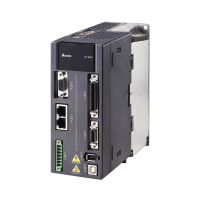AH500 Programming Manual
6-178
1.5
1
0.5
0 0.1 0.2 0.3 0.4 0.5 0.6 0.7 0.8 0.9 1
Time (sec)
K =40
P
K =20
P
K =10
P
SV=1
K =5
P
Step 2: When the K
P
is 40, there is overreaction. Thus, the K
P
is not chosen. When the K
P
is 20, the
reaction curve of the PV is close to the SV, and there is no overreaction. However, due to
the fast start-up, the transient output value (MV) is big. The K
P
is not chosen, either. When
the K
P
is 10, the reaction curve of the PV approaches the SV smoothly. Therefore, the K
P
is
chosen. When the K
P
is 5, the reaction is slow. Thus, the K
P
is not chosen.
Step 3: After the K
P
is set to 10, increase the K
I
. For example, the K
I
is set to 1, 2, 4, and 8
successively. The K
I
should not be larger than the K
P
. Then, increase the K
D
. For example,
the K
D
is set to 0.01, 0.05, 0.1, and 0.2 successively. The K
D
should not be larger than ten
percent of the K
P
. Finally, the relation between the PV and the SV is present in the following
diagram.
1.5
1
0.5
0 0.1 0.2 0.3 0.4 0.5 0.6 0.7 0.8 0.9 1
Time (sec)
PV=SV
K =10,K =8,K =0.2
P
I D
Note: The example is only for reference. Users have to tune the parameters properly according to
the practical condition of the control system.
Sample 1: Using the automatic tuning function to control the temperature
Purpose: Using the automatic tuning function to calcaulte the most appropriate parameters for the
PID temperature control
Explanation:
Due to the fact that users may not be familiar with the characteristics of the temperature
environment which is controlled for the first time, they can use the automatic tuning function to make
an initial adjustment (PID_MODE is set to 1). After the tuning of the parameter is complete,
PID_MODE is set to 0. The controlled environment in this sample is an oven. The program example
is as below.

